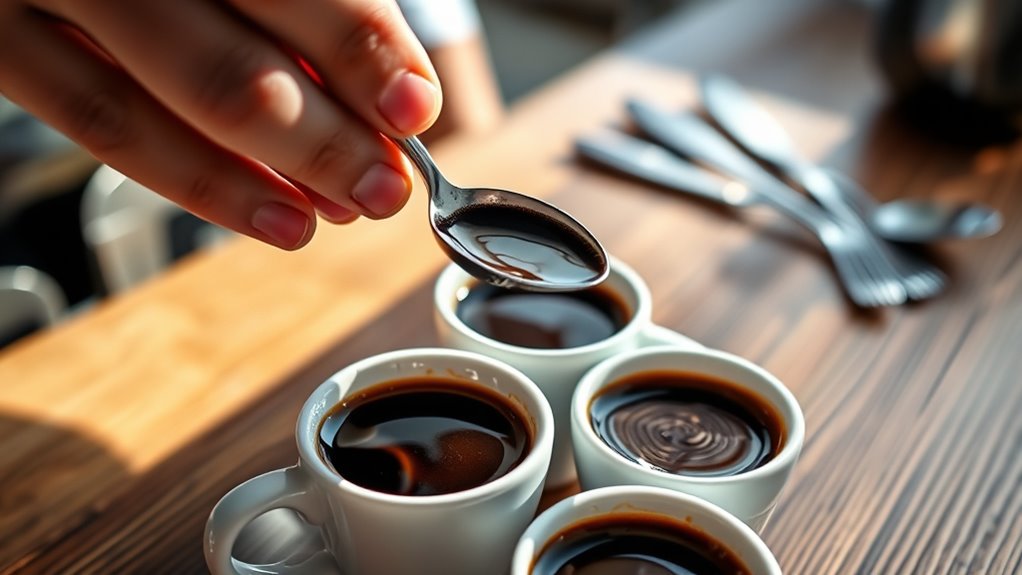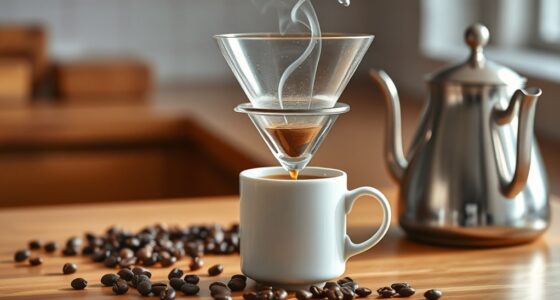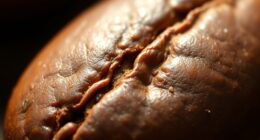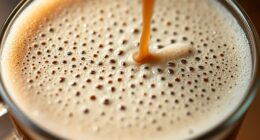To cup coffee like a pro, start by preparing your samples with consistent brewing methods—using the right grind size, water temperature, and brew ratio. Create a quiet environment, smell the aroma first, then slurp to aerate and taste the flavors, noting notes like fruit or chocolate. Assess body, aftertaste, and aroma to analyze the coffee’s complexity. With practice, you’ll refine your palate and access deeper layers of flavor—if you’re eager to perfect your technique, keep exploring these steps.
Key Takeaways
- Use standardized brewing methods and precise parameters to ensure consistent, high-quality coffee for tasting.
- Create a quiet, distraction-free environment to focus your senses and build a refined palate.
- Smell the coffee before tasting to identify aroma nuances and understand flavor development.
- Employ the “slurp” technique to aerate the coffee, enhancing flavor and mouthfeel perception.
- Record detailed observations of aroma, flavor notes, body, and aftertaste for accurate comparison and improvement.
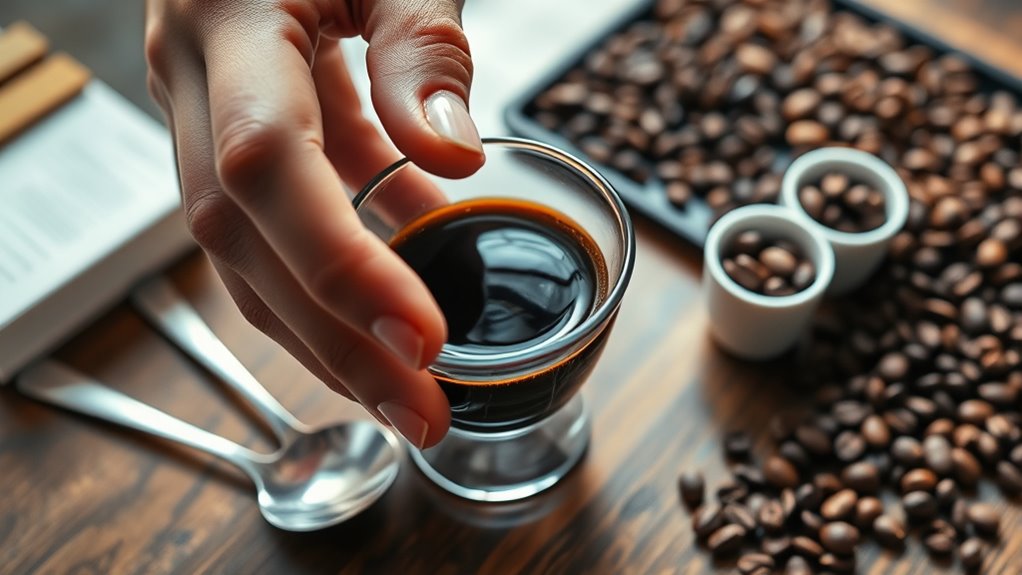
Mastering the art of coffee tasting involves more than just sipping your brew; it requires a deliberate approach to preparation, sensory evaluation, and technique. To start, you need to use standardized brewing methods like pour-over, drip, or French press. These methods help achieve consistent results, making it easier to compare different coffees accurately.
Pay attention to brewing parameters such as water temperature and brew ratio. Experimenting with these variables allows you to maximize flavor extraction, revealing more nuanced qualities of each coffee. Adjusting grind size is also essential; coarser for French press, medium for drip, and finer for pour-over, depending on the origin and roast level. Proper grind size enhances the coffee’s flavor profile, revealing subtle notes that might otherwise be masked.
Adjust brewing variables and grind size to unlock each coffee’s hidden flavor nuances.
Creating a quiet, distraction-free environment is equally important, as it helps focus your senses solely on the coffee. Familiarize yourself with a variety of coffee types to develop a baseline for comparison, which sharpens your palate over time.
Understanding coffee flavor profiles involves recognizing the complexity of flavors and aromas. As you taste, try to identify notes like chocolate, fruit, or nuts. Different origins, such as Ethiopian or Colombian beans, influence these profiles considerably, so knowing their typical characteristics guides your evaluation.
Aroma plays a key role as well—before tasting, smell the coffee to detect subtle nuances that add depth to the overall experience. Roast levels impact flavor: light roasts tend to be brighter and more acidic, while dark roasts offer smoky, robust flavors. Body and mouthfeel describe the texture and weight of the coffee in your mouth, differentiating between light, medium, and heavy-bodied brews. This understanding helps you appreciate the subtle differences in each cup.
Mastering your senses is essential to becoming proficient at tasting. Visual inspection involves observing the coffee’s color and clarity, which can hint at its flavor profile. Aromas should be carefully smelled to pick up delicate notes.
When tasting, notice the tactile experience—how the coffee feels on your tongue and palate. Employing the “slurp” method, which involves a quick, noisy intake of air along with the coffee, helps aerate it, releasing more flavors. This technique spreads the coffee across your tongue, allowing you to perceive subtle notes more clearly.
Cooling the coffee slightly can also reveal hidden acidity and fresh flavors, making it easier to differentiate between tastes. Evaluating texture and mouthfeel involves noting whether the coffee is light, medium, or heavy-bodied, and how it feels in your mouth. The finish or aftertaste reflects how long the flavors linger after swallowing, providing insight into quality and complexity.
Using tools like cupping charts and precise equipment guarantees a systematic approach, helping you record and compare different coffees accurately. Maintaining ideal temperature throughout brewing and tasting sharpens your sensory perception, ultimately elevating your coffee cupping skills. Additionally, understanding the significance of water quality can greatly influence the extraction process and final flavor profile.
With practice and attention to detail, you’ll develop the refined palate needed to appreciate coffee at a professional level.
Frequently Asked Questions
What Equipment Is Essential for Professional Coffee Cupping?
You need essential equipment like cupping bowls or containers that hold 175-300ml. High-quality burr grinders are important for consistent grounds. Kettles with long spouts are necessary for precise pouring.
Use cupping spoons for tasting, spittoons for disposal, and digital scales for accurate measurements. Don’t forget notebooks for notes, timers to track brewing, and towels for spills.
These tools guarantee professional, efficient, and consistent coffee cupping sessions.
How Do Ambient Conditions Affect Coffee Tasting Accuracy?
They say, “A bad workman blames his tools,” but in coffee tasting, your environment truly matters. If the room’s too hot or humid, your sensory perception can be distorted—volatile aromas may become overwhelming or muted, and grind consistency suffers.
Keep the temperature between 20-22°C and humidity around 40-60%. These stable conditions help guarantee your tasting is accurate, so you can truly appreciate each unique flavor note.
What Are Common Mistakes to Avoid During a Tasting Session?
During a tasting session, you should avoid rushing through the process, as it can cause you to miss subtle flavors.
Don’t discuss opinions loudly with others, which may influence their perceptions.
Make sure you use proper tasting equipment and follow a structured method to stay consistent.
Also, keep the environment neutral and free from strong odors or distractions.
Finally, record your notes accurately to improve your skills over time.
How Do Different Brewing Methods Influence Flavor Profiles?
Think of brewing methods as different musical instruments shaping a symphony of flavors. Drip brewing offers a balanced, mellow tune, while pour-over highlights bright, delicate notes. French press enhances body, and espresso delivers intense richness. Cold brew softens acidity, emphasizing sweetness.
Your choice influences aroma, clarity, and mouthfeel—each method playing its unique role. By understanding these differences, you craft a coffee experience that sings perfectly to your taste buds.
Can Coffee Tasting Skills Improve With Practice Over Time?
Yes, your coffee tasting skills can definitely improve with practice over time. When you practice regularly, you sharpen your senses, making it easier to detect subtle flavors and aromas.
Using tools like flavor wheels and aroma kits helps expand your vocabulary and understanding. Staying mindful during tastings, avoiding strong odors, and tasting on an empty stomach all enhance your sensitivity.
Consistent effort and learning will make you a more skilled taster.
Conclusion
Now that you’ve learned the art of coffee tasting, you’re like a skilled explorer uncovering hidden treasures in each sip. Every cup becomes a canvas, revealing vibrant flavors and subtle nuances that dance on your palate. With practice, your palate sharpens like a fine blade, slicing through the complexities to appreciate the full symphony of aromas and tastes. Embrace this journey, and let each cup deepen your connection to the rich, aromatic world of coffee.
